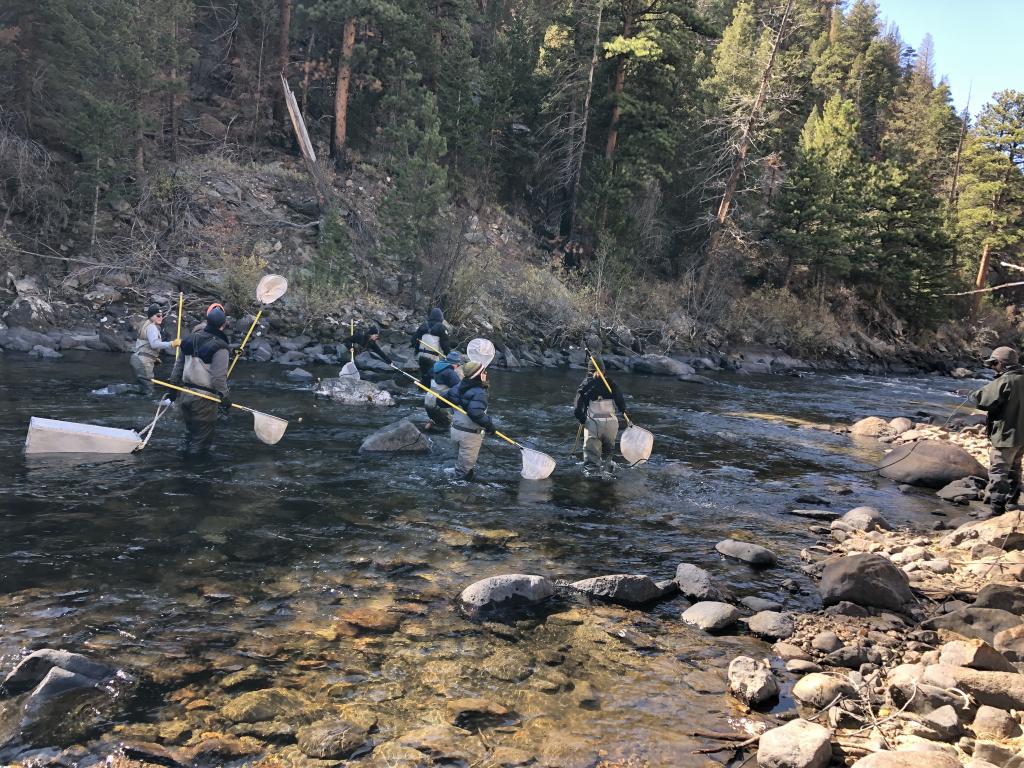Angling impacts to be expected on the Poudre River this summer

 Jason Clay
Jason ClayNortheast Region Public Information Officer
303-291-7234 / [email protected]
@CPW_NE

FORT COLLINS, Colo. - With snowmelt happening, river flows rising and fishing activity increasing, Colorado Parks and Wildlife (CPW) is issuing a reminder to anglers of the unfortunate current conditions on the Poudre River.
During July 2021 there was a catastrophic debris flow that had severe negative impacts on the Poudre River fishery downstream of the Black Hollow Creek confluence, located between Rustic and the Poudre River State Fish Hatchery.
“The plume of sediment and debris that moved downstream from that event led to fatal conditions in the river for fish due to heavy sediment loads preventing fish from exchanging oxygen across their gills, leading to the fish suffocating,” said CPW Aquatic Biologist Kyle Battige.
CPW documented dead fish the day after the debris flow, but was unable to assess the true impacts to the fishery until the fall when flows and sediment loads had decreased.
Battige led a team of aquatic biologists and technicians on a 10-day survey of the river last fall to assess and document impacts to aquatic resources. During that time period 12 unique stations were sampled along the Poudre River.
Three stations were above the Black Hollow Creek confluence, ranging from ½ to seven miles upstream, and nine stations were below, ranging from one to 46 miles downstream of the Black Hollow Creek confluence.
Two of the upstream stations had no noticeable change in the trout fishery. The station located a half mile upstream of the Black Hollow Creek confluence did see a reduction in overall trout numbers and a shift in size structure to primarily larger individuals. Downstream stations saw dramatic impacts.
“No fish, outside of a single brown trout that had migrated downstream between the dates of the debris flow event and sampling event, were captured during sampling within stations from one to 16 miles downstream of Black Hollow Creek confluence, suggesting a complete loss of the fishery within that reach,” Battige said. “It was not until the Stove Prairie station, 20 miles downstream, that trout were captured.”
Despite catching trout at Stove Prairie, numbers were 80 percent lower in 2021 compared to historic estimates. Working downstream from Stove Prairie, trout numbers were reduced, but the impact was less, which was expected. The further you moved downstream and away from the source of the sediment and debris, the less the impact.
However, Gateway Park (32 miles downstream) had a 70 percent reduction in trout numbers and Lyons Park (42 miles downstream) had a 45 percent reduction in trout numbers. It was not until Lee Martinez Park (46 miles downstream) that 2021 trout numbers were within historic averages. Even still, many dead trout and other fish species (longnose dace, white sucker and longnose sucker) were observed downstream of College Avenue as a result of the Black Hollow Creek event.
The Cameron Peak Fire was the largest wildfire in state history and its impacts continue to be felt.
“The 2022 spring runoff is flushing fine sediment deposited from the Black Hollow event downstream and helping reset the river,” Battige said. “However, it is unknown whether potential summer rain events will lead to another event similar to the Black Hollow Creek debris flow that could have further negative impacts on the Poudre River and its aquatic resources.”
CPW plans to begin stocking rainbow trout this summer in an attempt to rebuild the fishery and establish rainbow trout populations while brown trout numbers are reduced.
CPW advises anglers to not fish between Stove Prairie and Black Hollow Creek due to very low trout numbers in that reach. Poudre River anglers are advised to fish upstream of the Poudre River State Fish Hatchery or downstream of Stove Prairie, or even Gateway Park, to have the best chance at catching trout.

Figure 1. Trout population estimates - blue bars are historic estimates and orange bars are 2021 estimates. The vertical black dashed line represents the Black Hollow Creek confluence. Note: The substantial decrease from historic to 2021 estimates with no fish being captured downstream of Black Hollow until Stove Prairie. From Stove Prairie, downstream numbers were reduced until Lee Martinez Park, 46 river miles downstream.
Pictures Below (Courtesy of Jason Clay/CPW):
Left: Aquatic biologist Kyle Battige holds up dead trout pulled from the bank of the Cache la Poudre River on July 21, 2021, the day following the flash flood and debris flow on the river.
Right: Battige looking at the sediment load in the gills of a dead brown trout.


Colorado Parks and Wildlife (CPW) is an enterprise agency, relying primarily on license sales, state parks fees and registration fees to support its operations, including: 43 state parks and more than 350 wildlife areas covering approximately 900,000 acres, management of fishing and hunting, wildlife watching, camping, motorized and non-motorized trails, boating and outdoor education. CPW's work contributes approximately $6 billion in total economic impact annually throughout Colorado.
DISCLAIMER: The Colorado Parks and Wildlife (CPW) website maintains press releases containing historical information that may no longer be accurate. Press releases are dated, which should be noted to determine whether the information provided is current. Please review our current regulations and brochures for up-to-date information.